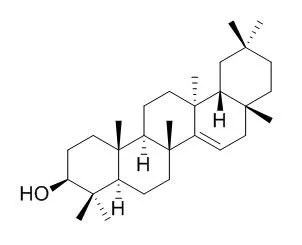| Appl Biochem Biotechnol. 2012 Oct;168(3):487-503. |
| Production of triterpenoid anti-cancer compound taraxerol in Agrobacterium-transformed root cultures of butterfly pea (Clitoria ternatea L.).[Pubmed: 22843061] |
Independent transformed root somaclones (rhizoclones) of butterfly pea (Clitoria ternatea L.) were established using explant co-cultivation with Agrobacterium rhizogenes.
METHODS AND RESULTS:
Rhizoclones capable of sustained growth were maintained under low illumination in auxin-free agar-solidified MS medium through subcultures at periodic intervals. Integration of T(L)-DNA rolB gene in the transformed rhizoclone genome was verified by Southern blot hybridization, and the transcript expression of T(R)-DNA ags and man2 genes was ascertained by reverse transcription polymerase chain reaction analysis. The major compound isolated and purified from the transformed root extracts was identified as the pentacyclic triterpenoid compound Taraxerol using IR, (1)H-NMR, and (13)C-NMR spectroscopy. The Taraxerol yield in cultured hairy roots, as quantified by HPTLC analysis, was up to 4-fold on dry weight basis compared to that in natural roots. Scanning of bands from cultured transformed roots and natural roots gave super-imposable spectra with standard Taraxerol, suggesting a remarkable homology in composition.
CONCLUSIONS:
To date, this is the first report claiming production of the cancer therapeutic phytochemical Taraxerol in genetically transformed root cultures as a viable alternative to in vivo roots of naturally occurring plant species. |
| Geochim. Cosmochim. Ac., 2004, 68(3): 411-22. |
| Taraxerol and Rhizophora pollen as proxies for tracking past mangrove ecosystems 1 1 Associate editor: R. Summons[Reference: WebLink] |
METHODS AND RESULTS:
Angola Basin and Cape Basin (southeast Atlantic) surface sediments and sediment cores show that maxima in the abundance of Taraxerol (relative to other land-derived lipids) covary with maxima in the relative abundance of pollen from the mangrove tree genus Rhizophora and that in the surface sediments offshore maxima in the relative abundance of Taraxerol occur at latitudes with abundant coastal mangrove forests.
Together with the observation that Rhizophora mangle and Rhizophora racemosa leaves are extraordinarily rich in Taraxerol, this strongly indicates that Taraxerol can be used as a lipid biomarker for mangrove input to the SE Atlantic. The proxy-environment relations for Taraxerol and Rhizophora pollen down-core show that increased Taraxerol and Rhizophora pollen abundances occur during transgressions and periods with a humid climate. These environmental changes modify the coastal erosion and sedimentation patterns, enhancing the extent of the mangrove ecosystem and/or the transport of mangrove organic matter offshore.
CONCLUSIONS:
Analyses of mid-Pleistocene sediments show that interruption of the pattern of Taraxerol maxima during precession minima occurs almost only during periods of low obliquity. This demonstrates the complex environmental response of the interaction between precession-related humidity cycles and obliquity-related sea-level changes on mangrove input. |
| Cell J . 2017 Oct;19(3):512-519. |
| Taraxerol Induces Cell Apoptosis through A Mitochondria-Mediated Pathway in HeLa Cells[Pubmed: 28836414] |
| Abstract
Objectives: Taraxerol acetate has potent anti-cancer effects via the induction of apoptosis, autophagy, cell cycle arrest, and inhibition of cell migration. However, whether Taraxerol induced apoptosis and its underlying mechanisms of action is not clear. In the present study, we assess the effects of Taraxerol on the mitochondrial apoptotic pathway and determine the release of cytochrome c to the cytosol and activation of caspases.
Materials and methods: In this experimental study, we mainly investigated the effect of Taraxerol on HeLa cells. We tested cell viability by the MTT assay and morphologic changes, analyzed apoptosis by DAPI staining and flow cytometry. We also determined reactive oxygen species (ROS) and mitochondrial membrane potential (MMP) using a Microplate Reader. In addition, the apoptotic proteins were tested by Western blot.
Results: Taraxerol enhanced ROS levels and attenuated the MMP (Δψm) in HeLa cells. Taraxerol induced apoptosis mainly via the mitochondrial pathway including the release of cytochrome c to the cytosol and activation of caspases 9 and 3, and anti-poly (ADPribose) polymerase (PARP). Taraxerol could induce the down-regulation of the anti-apoptotic protein Bcl-2 and up-regulation of pro-apoptotic protein Bax. It suppressed the PI3K/ Akt signaling pathway.
Conclusions: These results demonstrated that Taraxerol induced cell apoptosis through a mitochondria-mediated pathway in HeLa cells. Thus, Taraxerol might be a potential anticervical cancer candidate.
Keywords: Apoptosis; HeLa Cells; Mitochondria; Taraxerol. |
| Cell J . 2017 Oct;19(3):512-519. |
| Taraxerol Induces Cell Apoptosis through A Mitochondria-Mediated Pathway in HeLa Cells[Pubmed: 28836414] |
| Abstract
Objectives: Taraxerol acetate has potent anti-cancer effects via the induction of apoptosis, autophagy, cell cycle arrest, and inhibition of cell migration. However, whether Taraxerol induced apoptosis and its underlying mechanisms of action is not clear. In the present study, we assess the effects of Taraxerol on the mitochondrial apoptotic pathway and determine the release of cytochrome c to the cytosol and activation of caspases.
Materials and methods: In this experimental study, we mainly investigated the effect of Taraxerol on HeLa cells. We tested cell viability by the MTT assay and morphologic changes, analyzed apoptosis by DAPI staining and flow cytometry. We also determined reactive oxygen species (ROS) and mitochondrial membrane potential (MMP) using a Microplate Reader. In addition, the apoptotic proteins were tested by Western blot.
Results: Taraxerol enhanced ROS levels and attenuated the MMP (Δψm) in HeLa cells. Taraxerol induced apoptosis mainly via the mitochondrial pathway including the release of cytochrome c to the cytosol and activation of caspases 9 and 3, and anti-poly (ADPribose) polymerase (PARP). Taraxerol could induce the down-regulation of the anti-apoptotic protein Bcl-2 and up-regulation of pro-apoptotic protein Bax. It suppressed the PI3K/ Akt signaling pathway.
Conclusions: These results demonstrated that Taraxerol induced cell apoptosis through a mitochondria-mediated pathway in HeLa cells. Thus, Taraxerol might be a potential anticervical cancer candidate.
Keywords: Apoptosis; HeLa Cells; Mitochondria; Taraxerol. |






 Cell. 2018 Jan 11;172(1-2):249-261.e12. doi: 10.1016/j.cell.2017.12.019.IF=36.216(2019)
Cell. 2018 Jan 11;172(1-2):249-261.e12. doi: 10.1016/j.cell.2017.12.019.IF=36.216(2019) Cell Metab. 2020 Mar 3;31(3):534-548.e5. doi: 10.1016/j.cmet.2020.01.002.IF=22.415(2019)
Cell Metab. 2020 Mar 3;31(3):534-548.e5. doi: 10.1016/j.cmet.2020.01.002.IF=22.415(2019) Mol Cell. 2017 Nov 16;68(4):673-685.e6. doi: 10.1016/j.molcel.2017.10.022.IF=14.548(2019)
Mol Cell. 2017 Nov 16;68(4):673-685.e6. doi: 10.1016/j.molcel.2017.10.022.IF=14.548(2019)